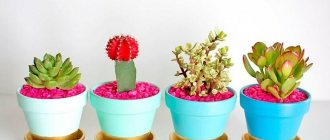Modern design style involves the use of concrete mixture. This material is used in construction, and by amateurs or professional designers to form small objects. You can make concrete pots with your own hands using individually designed molds. This will allow you to complement your landscape design and interior with an original product.
Vase made of concrete and wood finishing
Durable building material requires compliance with the rules for preparing the solution. A high-quality mixture consists of 1 part cement, 2 parts sand, 4 parts aggregate, 0.5 parts water. To increase the strength of the structure, a reinforced frame is used.
The glossy surface is formed by sanding with a special machine using a felt wheel and paste. After processing, the product is coated with a layer of polymer composition.
To make flower pots from concrete and wood trim, you need to take a juice box and cut off the top. The filling composition is prepared by mixing the ingredients with the addition of water. To reduce the number of bubbles in the mixture, add a little more liquid.
The prepared composition is poured into the box. After this, the cut-off part of a smaller size is lowered into the mold filled with the mixture and pressed into place to a depth of 2-3 cm and secured with tape. The product is left for several hours so that the concrete takes on the desired configuration.
After the concrete takes its final form, remove the boxes that act as forms and proceed to surface treatment using a grinding machine. For wooden finishing, blanks are cut taking into account the dimensions of the concrete frame. The bars are fastened with a stapler, and the metal plate is screwed on using an electric drill.
The fasteners are securely fixed and attached in a vertical position. Finally, you should test the finished product and check the tightness of the connection to the pot.
Among the variety of finishes, the combination of concrete with a wooden stand is considered successful. An excellent combination of artificial stone and solid wood involves the manufacture of a product consisting of 2 complementary parts.
Making the bottom of the pot
There are several ways to make the bottom of artificial stone containers.
We use the following.
After drying the workpiece with a handle, it looks like this.
From non-woven material, cut out a circle of size equal to the inner circumference of the pot.
We prepare a solution of a mixture of sand and cement of the medium sour cream type.
Place the pot blank on plastic wrap. Pour the solution inside the workpiece. We slightly vibrate the workpiece.
It is necessary that the solution spreads and partially falls under the bottom edge of the pot. Smooth out any excess mixture that has come out with a brush. If necessary, we apply additional solution to it.
Place and compact the cut out circle of fabric on the bottom. After leveling, pour another layer of a more liquid cement mixture.
Using a brush with this mixture, we pass along the top and inner surface of the pot.
We smooth out unevenness with a brush slightly moistened with water or very liquid cement.
Cover the pot with plastic wrap. Let it dry for a day.
How to make a cactus pot from concrete and glass
The decorative element for succulents is simple and does not require financial costs. To make concrete pots for cacti, take glass molds, wash them and wipe them dry. After spraying white or black paint, the workpiece is left to dry.
The preparation of the cement mixture is carried out taking into account the recommendations. In this case, it is important to achieve a thick consistency of the material that will be held on the surface of the mold. The glass frame is lowered into the mixture.
To color the composition and give the concrete a different shade, an emulsion is applied to part of the form before it hardens. If the concrete has dried, the coloring composition is again applied to the surface to achieve a uniform and bright shade.
To make a concrete pot look original, the monochromatic color is diluted with contrasting lines, splashes, and patterns. The glass frame can be installed in the mold so as to leave part of the product transparent. The choice of base configuration and product design depends on personal preferences and creative ideas.
Useful tips
Experienced craftsmen willingly share their secrets of craftsmanship, using which they can obtain not only a bright and original product, but also one that is sufficiently durable and of high quality.
For this reason, it is useful for beginners to listen to these recommendations:
- After hardening, the workpiece is carefully inspected. If obvious defects are detected, it is not recommended to cut off excess parts. Such actions can cause even more serious damage, as well as chipping. To eliminate identified deficiencies, it is rational to use sandpaper, smoothing out all the irregularities.
- When choosing a color, it is better to give preference to bronze and greenery. These shades of acrylic paints will look most advantageous among the riot of natural colors in the garden.
- It will be easier to coat the product with acrylic paint if you add white sand to the cement mortar. A good alternative is to coat the piece with plaster before painting it.
We must not forget that such decorative products are created not only to decorate the surrounding space. Summer residents plant flowering crops in them. Taking this into account, it is recommended to form a drainage hole at the bottom of the products through which excess liquid will escape.
So, it won’t be difficult to create flowerpots for the garden with your own hands from cement and rags if you carefully read the step-by-step instructions and arm yourself with detailed recommendations.
Author: Vladimir
Manufacturing technology for hanging pots for indoor plants
For flower arrangements, you can use a concrete pot made from various shapes and devices:
- containers;
- plastic containers;
- household plastic;
- burlap and rags;
- burdock leaf;
- things and shoes.
A concrete planter can be made from any object adapted for pouring the mixture. Hanging pots save space. Products with flowers can be placed at different levels, decorate an opening or a terrace.
To make a flower pot you will need a silicone mold, which you can make yourself. As a starting model, you can use laser-cut plywood according to an invented drawing in a geometric style.
To make the walls more resistant to deformation, the model is made of 2 parts - an external frame and an internal liner. After gluing the parts, use sandpaper to remove any irregularities and cover them with matte paint. After surface treatment, defects appear that can be easily eliminated mechanically.
A piece of cardboard is used as formwork for pouring. To prevent the silicone from sticking to the surface, the mold is treated with a release agent. To create a cavity, an insert is inserted into the structure. Silicone is poured in a thin stream from a height of 1 point so that the composition fills all the voids and the container. The polymerization process of the material occurs within 24 hours.
After the mass has hardened, the mold is removed, the excess is cut off and used to cast flowerpots. When mixing and pouring the composition, it is recommended to knock on the sides of the mold to help release air bubbles.
Mineral pigments of various colors are added to the concrete mixture. You can use bottles and mugs for filling. Cones and pyramids are made from a special polymer composition that can be easily rolled out with a rolling pin. These forms are filled with concrete and formed into pots with a cavity for planting flowers.
Complex figures with a frame
It’s more fun to decorate your country house with sculptures of animals and mythical characters. Such creations involve the preliminary production of a durable frame and layer-by-layer application of cement mortar.
Interesting flowerpots can be made using buckets from construction mixtures. At the first stage, a container of suitable size is wrapped with a plaster mesh and covered with a thick layer of cement. At the second stage, until complete hardening, decorative adjustments are made, making an imitation of an old stump with natural wrinkles on the bark.
A monolithic figure of a hippopotamus would look appropriate near artificial reservoirs. The place for it must be determined immediately and carefully aligned, since in the future the figure will be stationary.
Two elongated plastic basins, which must be fastened with wire, are suitable as a frame. Another option is also possible: a thick cement solution is covered on top of a pile of broken bricks or crushed stone.
The figure itself does not contain complex elements and is easy to perform. After hardening, the product is treated with fixing impregnation and dry pigment for concrete, rubbing the powder with a hard sponge.
More complex sculptures are made in several stages: 1) making a frame from wire and foam plastic or containers; 2) covering the workpiece with a plaster mesh; 3) applying the mixture in several layers; 4) formation of small details (facial features, special texture, folds of clothing, etc.); 5) priming and painting the finished work.
Flowerpots in the shape of swans will become an elegant decoration of the garden. The body frame is an old plastic basin, the neck is woven wire. The head, wings and imitation plumage will have to be made from a cement mixture, showing the skills of a sculptor.
Monolithic figures have a significant weight, so as an alternative there is a way to create lightweight large objects. You can decorate your garden with boulders of different sizes.
To make them, any unnecessary and lightweight material (cuts of polyurethane foam, plastic bottles, polystyrene foam) is tied into a tight lump with wire.
The resulting base is wrapped in a plaster mesh and covered with thick cement mortar. The more irregularities and protrusions there are, the more natural the “stone” will look.
Small garden figurines are made from a mixture of cement with the addition of gypsum or Portland cement.
Here you can use the manufacturing methods described above, as well as any basics: old toys, items of clothing, household utensils.
Shape of hardened concrete towel
To create a product of an unusual configuration, any material that retains its original appearance for 5 hours is useful. After polymerization of the composition, the structure becomes stable. Thick cardboard, plastic products, plywood boards, and towels are often used to make molds.
The cement mixture for pouring should not be too liquid, so when preparing it it is better to achieve the consistency of thick sour cream. Cover the bucket with a towel and turn it over so that the concrete saturates the inside.
The length of the fabric blank should be adjusted before pouring the concrete. The towel is completely lowered into the bucket and soaked in the composition. When the task of saturating the fabric is completed, the towel is thrown over the bucket and left to dry. The average curing time is from 48 to 72 hours.
When working with cotton fabric, cement tile adhesive is used instead of concrete. It is recommended to choose quick-drying mixtures intended for outdoor use that are resistant to temperature changes.
The prepared rags are thoroughly moistened in the solution, wrung out and again immersed in cement. After impregnation, they are hung, draped on the body of the form, trying to give an interesting configuration. Beautiful texture is inherent in burlap products.
Large concrete pots made from old buckets
Massive improvised objects are used to make decorative elements used in landscape design. A master class on making flower pots with your own hands can be taken at specialized art centers in Moscow.
The principle of working with concrete when using old buckets is reminiscent of making Easter cakes. To make a cement pot without voids, the substance should be mixed well, and pebbles should be added to obtain a shaped accessory.
Large pots are decorated with multi-colored tiles and accessories. Before you start working with the cement composition, it is recommended to protect your hands from exposure to concrete. You should work with gloves. If a crack appears in the finished product when removed from the mold, the defect must be eliminated by covering it with fresh solution.
Planters for the garden made of cement
If you want to make a cement planter with your own hands for the garden, then you should first consider the important rules and features of the process of making it. It is quite simple, but there are still some principles that must be followed.
To make a large pot or flowerpot, you will need to prepare the following components:
- a mold made of a plastic base, the diameter should be 53 cm and the height should be 23 cm;
- the solution will require white cement, perlite (agroperlite), high-moor peat;
- oilcloth or cellophane, you need to take a bag or a piece that will cover the entire surface of the plastic container;
- metal wire frame or reinforcing structure;
- cleaning brush.











